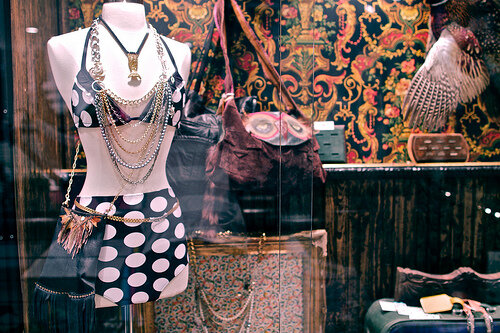…THIS PAGE IS CURRENTLY BEING UPDATED…
BEST JEWELRY IN NEW YORK
As a former full-time buyer for indie jewelry store Catbird, Old Hollywood owner Tiffany Porter has a talent for discovering distinctive young designers. She launched this 300-square-foot Greenpoint nook in October, focusing on vintage-inspired accessories. Around twenty lines are displayed in the drawers of an antique wardrobe and dangling off shelves. Many are exclusive to the store, like VeridiAum’s leather and rose gold rings, the chunky scarab and quill trinkets from Withering Elm, and elaborate layered necklaces strewn with vintage brooches by Harlow in Chains. The prices are excellent, too: starting at $20 for a brass charm bracelet and topping out at $300 for an oversize gold cocktail ring.
- NEW YORK MAGAZINE
BROOKLYN’S BEST ENTREPRENEURS
TIFFANY PORTER + ALEX SHULHAFER OF OLD HOLLYWOOD.
Vintage buyer Tiffany Porter cultivated over the years a time-leaping collection of nostalgia from roaring flapper to rockabilly to moxie mod. In fall 2008 she opened Old Hollywood in Greenpoint, Brooklyn, to showcase and sell her wares, a boutique fine-tuned by partner Alex Shulhafer. The main display case in the store (pictured) includes a handmade, vintage-inspired bathing suit by Elizabeth O'Brien Berg, a mermaid tail necklace by Audilou, and a taxidermy pheasant, personally caught and stuffed for Tiffany.
-INC. MAGAZINE
HOME DESIGN IDEAS WITH TIFF PORTER
RACKED : BETTER KNOW A SHOP OWNER
Photos by Daniel Krieger
Tiffany Porter, the owner of Old Hollywood, became a store owner by accident. Her original business plan had "open a shop" penciled in next to "when I have kids," but she got such a great deal on her first place in Brooklyn that she expedited the process. She debuted an Old Hollywood location in Greenpoint, did a stint in the Limelight Marketplace, and then added another boutique on the Lower East Side. Somehow, she still finds the time to work as a stylist and shop for the perfect classic, sometimes vintage-style pieces to fill her shop.
Have you always wanted to own a store? What made you want to start Old Hollywood?
I have not always wanted to open a store, actually. My focus was styling first. I wanted to do that, and I still do that. I studied sociology in college, so it wasn't exactly what I was thinking I was going to do, but I always worked in a shop. I worked in a store when I was in college and I loved it. But I'm from Kentucky, so you don't see this kind of thing. Project Runway when I was growing up did not exist. You didn't see this element of the fashion industry where I'm from.
The shop came about because I got a really awesome deal on the space. And then it just grew from there. At first, I could have the shop and freelance and do my own thing on the side, and then it kind of spiraled out of control. This is like my full-time job. But this year is the first year that I've actually been able to settle down and style again, because this is the first year that I haven't been opening a new shop or moving one. I opened a shop in Limelight, and then I closed it. Then, I moved the shop [from Meserole Street to Franklin Street] and opened one on the Lower East Side.
What was it like in Limelight?
From the beginning, I had kind of a bad feeling about it. But I had already signed up and given all this money so it was only forward. I was trying not to listen to other people and just focus on my thing. We opened, and opening day was good. It was kind of strong but it never really got there, and then it just plummeted. People left, and then they wanted to redo the whole thing. Really, it looks like a giant Daffy's now.
You said you got a good deal on your first store, which was in Greenpoint. Were you looking at other places before you looked in that neighborhood?
My first shop in Greenpoint was on Meserole Street, and we weren't looking anywhere. I started a jewelry company, and my business plan was to do all these other things and then in seven years open a store. The shop was an afterthought. For me it was, build my styling career, build my jewelry company, and then open a shop when I'm ready to have kids. And it wasn't even necessarily here. Then while I was writing that plan, my friend was like, "Oh, the space next door to mine is for lease and it's really cheap."
After the store was open, we looked around. We were dabbling with the thought of doing something in Carroll Gardens. We looked around Park Slope. If we were going to be in Williamsburg, we wanted to be really close to Bedford, if not on Bedford. But we started to realize that we couldn't afford it. It's so expensive, and everything around it was just too risky. We were looking for a place kind of by where the old Relish used to be—Wythe, that area. But it just didn't feel right. This is where we wanted to be, on Franklin Street, and when we were looking this wasn't available yet. When it came up we got it right away. If you're going to be in Greenpoint, you want to be on Franklin Street. And this street is only going to grow and get better.
And I'm glad that we have our own shop on the Lower East Side now. Since it's south of Delancey, it's kind of very new over there. It's kind of trickling down, and hopefully I'll see that neighborhood really grow. Right now, it's like we got in and it's still early. And so I think that's going to be really good for us to be in the Lower East Side.
When you think of your customer, who do you think of?
I see myself, because I shop and buy for myself. But I do buy things that I wouldn't necessarily wear that I know my customer will wear. She's a little bit older, she might have kids, she might have a day job. Some things I buy are a little more conservative and are things you can wear to the office but are still a little edgy.
Aside from that, I try to buy within a certain realm of class: things that won't go out of style. I started out as a vintage buyer in the vintage realm, and that's what I'm the most knowledgeable about. I try to buy pieces that are classic, that have been around and are going to stay around. They're things that you can wear again and again, even if it's not a super expensive item. You can get an $80 or $100 pair of pants that will hopefully never go out of style, and that's going to be classic to a degree. I mean, some of the crazy stuff—like the prints and everything—they go in and out.
But even if you get trend-based stuff, if you get something that's really nicely made and looks good, you can have it forever. I buy a lot of classic '40s and '50s looks. That kind of stuff will always be flattering on women. There's nothing that's going to make a waist-cincher outfit out of style. And I'm kind of learning more about the men. I hired a buyer to help me more with the menswear because I'm very like, workwear dude on a motorcycle-type, and that's not everybody. There's a lot more fashionista-y men around here.
What's your philosophy on pricing?
I'm still learning the neighborhood, and the neighborhood is growing, so sometimes I'll be surprised. As far as clothes go, the most expensive item I think I'll carry is a very beautiful silk dress for $250 max. Mainly, it's $200 and under. The average price in here for clothes is going to be $80. The blankets can get expensive, but it all depends on where it's made.
Sometimes I reach. I have these bags that are $400. They do sell, but they hang out. That customer will come in and spend the money, but those are the reach pieces that I just get because I love them. I think I can be a little more expensive than some of the shops around me, but In God We Trust is around the corner and she's high, so I'm trying to find that balance. Only about 20% to 30% of my stuff is made in China. I try to buy a lot of things that are locally made, and that can get expensive. Jewelry, too. I don't have anything that's over $700, and my average jewelry price is about $120. And then it goes down: I have things that are $5. Anybody can come in here and find something.
What merchandise in the store right now are you the most excited about?
I'm the most excited about this line called Boho Gypsy. It's this woman who's from India, and she's gone back to India and her parents are textile merchants, and she's remaking all this old native tribal stuff. [The jewelry] is really vibrant, and they're a little bit shocking so not everybody can wear them. They're so unique—you can wear them in your hair! I'm also really excited about Dolce Vita. They're always killing it, and their line is so strong. I also just started carrying this new company called Betina Lou. She's a Canadian designer who does beautiful, really classic school-girl tailored pieces.
Also, this company called Red Cloud Collective. They just started and they're from Portland and everything's handmade. They do these beautiful leather tool bags, pretty manly stuff. And then these awesome iPhone cases that are like leather wallets, and then have a notepad inside. It's this group of skaters and artists who's a friend of the guy who does all my lookbook photography.
If you could carry anything that you currently don't carry, what would it be?
Mara Hoffman. I'm harassing her. I met her the other day at her sample sale and I was like, Mara. And then for men, which I won't ever be able to carry, is The Hill-Side. They have a shop, Hickoree's, and it's just the best. And they're at In God We Trust, so I can't carry them, but I'd love to.
Time for the lightning round. 1960s, 1970s, or 1980s?
Hmm, I would say the '60s. It's closer to the '50s, the shapes are still there. Patterns are coming in but not too much polyester. The '80s...are alright. But there's a time and a place.
Mad Men or Game of Thrones?
I've never seen Game of Thrones! I don't even know what it's about. Is it medieval?
I think so.
Yea, Mad Men. The '40s and '50s are my favorite decades, hands down.
Mustard or mayo?
Mustard. I don't eat mayonnaise. I like Miracle Whip, though. But I will still choose mustard. And I like spicy mustard.
Last one. Jay-Z or Kanye West?
Oh, Jay-Z. I fucking can't stand Kanye West.



